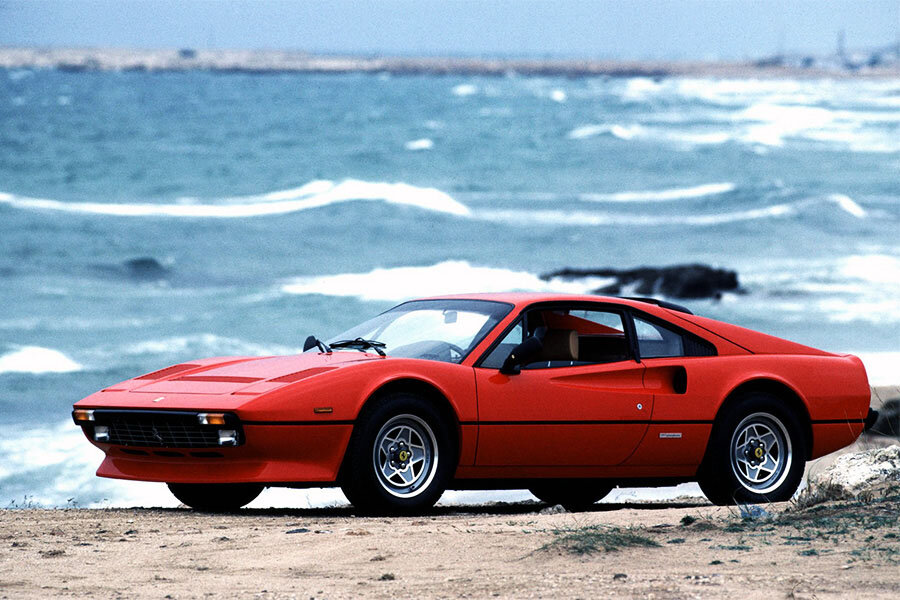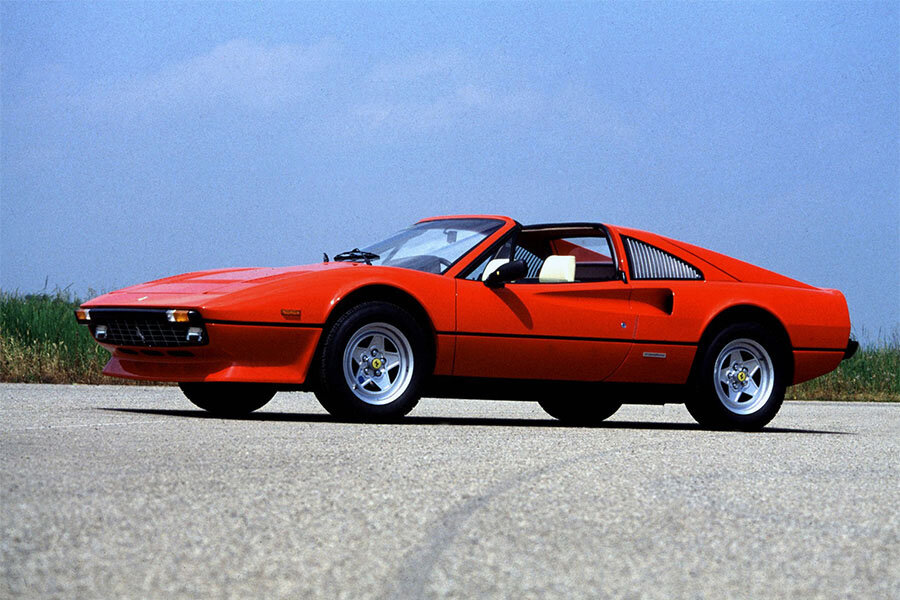Guide: Ferrari 308 GTB Quattrovalvole & 308 GTS Quattrovalvole - a Historical & Technical Appraisal
/BACKGROUND
During the late 1970s and early 1980s, ever tightening emission legislation really sapped the power from Ferrari's engines.
However, the firm's engineers worked hard to find a solution and, in 1982, the potency of Maranello’s normally aspirated V8s was restored. After the Mondial Quattrovalvole debuted at Geneva in March, the 308 Quattrovalvole followed suit at the Paris Motor Show in October.
Like the new Mondial, this latest 308 incorporated four valve cylinder heads which restored output to that of the old wet-sumped carburettor V8 from the 1970s.
The 308 Quattrovalvole also ushered in driveability and build quality improvements that made it arguably the best 308 of all.
It was the last iteration of what had become an exceedingly popular model before Ferrari launched the face-lifted 328.
Like earlier iterations, the 308 Quattrovalvole could be ordered as a Berlinetta (GTB) or Spider (GTS). The latter featured a removable targa top that could be stowed neatly behind the seats.
Production ran alongside the mid Flat 12-engined 512i BB (and briefly the Testarossa which replaced it). There was also the four-seat V12-engined 400i and the aforementioned Mondial which had a mid-mounted V8 engine and 2+2 cockpit layout.
Meanwhile, 45km up the road, Ferrari's biggest rival was undergoing something of a renaissance. The Mimram brother's takeover at Lamborghini had given renewed impetus to the Sant’Agata firm. With the Jalpa, the Bolognese auto maker was able to offer their first 308 rival in years.
ENGINE / TRANSMISSION
Thanks to a significant overhaul, Ferrari’s all-alloy V8 engines were also revived.
In addition to the new four valve cylinder heads, the latest Tipo F105 AB 000 engine was further enhanced with flat-top pistons and Nikasil-lined cylinder heads (instead of cast-iron).
Compression was increased from 8.8:1 to 9.2:1.
The new engine was identifiable by its its crackle red intake box finished with Ferrari Quattrovalvole script.
Fuel-injection was via the Bosch K-Jetronic system.
Marelli Digiplex electronic ignition included a coil, distributor and ignition module for each bank of cylinders.
Displacement remained unchanged at 2926cc thanks to a bore and stroke of 81mm and 71mm respectively.
Peak output jumped from 214bhp at 6600rpm to 240bhp at 7000rpm. The torque rating was also substantially improved with 191lb-ft at 5000rpm compared to 179lb-ft at 4600rpm.
New gear ratios were fitted to the five-speed manual ‘box and the final drive was optimised.
As usual, the wet-sump DOHC engine was mounted transversely with the gearbox located below the engine and to the rear of the sump. Power was transmitted via a single-plate clutch and limited-slip differential.
CHASSIS
Both tubular steel chassis used for the GTB and GTS were renumbered. The GTB switched to type number F106 GB 100 (from BB 100) and the GTS to F106 GS 100 (from BS 100).
Suspension was via unequal length wishbones, coil springs and telescopic Koni dampers plus anti-roll bars at either end.
As before, the twin fuel tanks had a combined 74-litre capacity and were mounted either side of the engine, up against the rear bulkhead.
Brakes were ventilated discs on all four wheels that ran off a separate hydraulic circuit for each axle.
The standard wheels were initially of the existing 308 design but now came with dark grey spoke centres. These were metric sized wheels designed for Michelin's low profile TRX tyres. Conventional imperial wheels were also available with Pirelli P7 tyres. Both types of wheel were manufactured by Speedline.
BODYWORK
Although at a quick glance the 308 Quattrovalvole appeared identical to its predecessor, Pininfarina added a couple of subtle updates that would give the design one final lease of life.
Most notably, the front grille was re-shaped to accommodate an exposed fog light in each corner.
A new shallow bank of radiator cooling louvres were carved out from the front lid (as seen on the 208 Turbo).
Additionally, slim rectangular indicators were fitted on each front fender and electric Ferrari-branded wing mirrors were installed on both sides as standard.
Apart from the front lid (aluminium) and the front and rear aprons (glassfibre), the rest of the body panels were steel.
The GTS version featured a fibreglass targa roof upholstered in hard-wearing black vinyl.
Whereas the GTB had semi-louvred rear three quarter windows, those on the GTS were fully louvred.
Both GTB and GTS versions were available from the start of production.
INTERIOR
Like the exterior, some slight alterations were made to the cockpit.
A 208 Turbo steering wheel was fitted which featured dished and partially upholstered spokes plus a more triangulated centre.
The electric wing mirror control was moved to the driver’s door armrest.
There was also new striped cloth headlining and the small overhead console was redesigned.
The only other change of note came under the front lid where the old zippered protective upholstery panel was deleted.
Although interior design was heading into the boxy digital era, Ferrari retained the same classic layout used on earlier 308s. All the updates that arrived with the first fuel-injected models were carried over. This included the revised centre console with its angled instrument pod and window controls plus patterned door panels and seat centres.
Confusingly the old GTBi and GTSi glovebox badges were retained.
The main instrument binnacle housed a large speedometer and tachometer, between which were smaller gauges for fuel, oil pressure and water temperature. The aforementioned angled pod on the centre console was home to a clock and oil temperature gauge.
OPTIONS
A number of new options became available to include fabric seat centres and a matt black BB-style basket handle rear aerofoil (standard in Japan).
Instead of the metric wheels and Michelin TRX tyres, 16-inch Speedline wheels shod with Pirelli P7 tyres could be ordered. These five-spoke alloys measured 7 and 8-inches wide front to back.
Other options included a deep front spoiler, metallic paint, air-conditioning and fitted luggage.
The satin black Boxer paint finish was dropped.
WEIGHT / PERFORMANCE
Weight of the new model was 1275kg in GTB trim and 1286kg for the GTS.
Top speed was 158mph and 0-62mph took 5.9 seconds.
USA VERSION
As usual, those examples destined for the USA (plus Japan and Australia) differed slightly. However, thanks to the four valve cylinder heads, the power deficit was minimised.
Despite the addition of catalytic converters, different Marelli Digiplex and a lower compression ratio (down to 8.6:1 from 9.2:1), output only dropped to 230bhp at 6800rpm (a 10bhp reduction).
There was also additional safety equipment: bigger impact-absorbing bumpers and a reinforced rear bulkhead contributed to a near 120kg weight gain.
Other modifications included large sidelight reflectors, all-amber front bumper lights, a shrouded exhaust, boxier wing mirrors and an extended bank of engine cover louvres. The front lid and headlight louvres were painted satin black (as on the 208 Turbo).
Ferrari installed smaller fuel tanks with an overall capacity of 70-litres.
PRODUCTION CHANGES
The only update came in January 1984 when Zincrox coating was applied to the steel panels for better rust protection.
END OF PRODUCTION
Production of the 308 Quattrovalvole ran from October 1982 until August 1985 when it was replaced by the 328 which came with a revised body, interior and mechanicals.
During its three year lifespan, just under 4000 308 Quattrovalvoles were built.
This comprised 748 GTBs (74 in right-hand drive) and 3042 GTSs (233 in right-hand drive).
These figures took combined production for the two-seat 308 variants to over 12,000 units.
Text copyright: Supercar Nostalgia
Photo copyright: Ferrari - https://www.ferrari.com

































